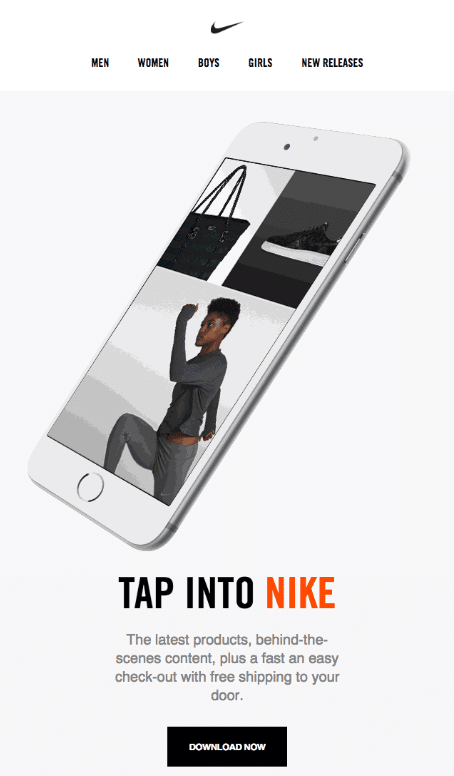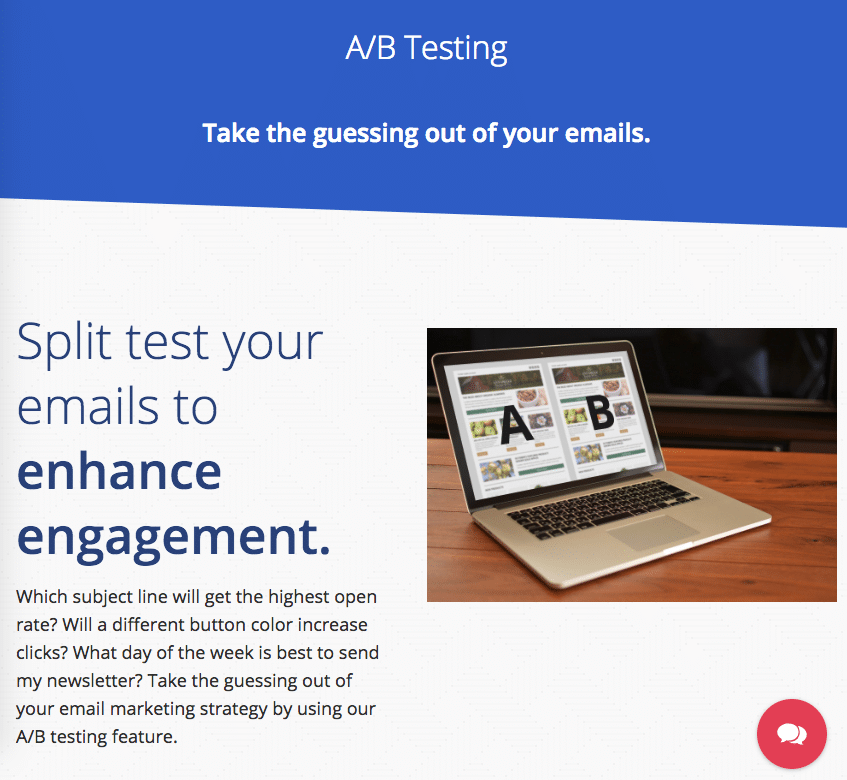How do you execute email marketing for mobile apps?
- Plan your goals ahead of time
- Develop a pre-launch strategy
- Preview and test your campaign
- Launch and expect problems
- Use data to plan your post-launch strategy
Why email marketing for mobile apps is more valuable than social media
Mobile usage is growing worldwide, and it doesn’t appear to be slowing any time soon. In fact, as of last year alone, there were over 3 billion mobile internet users.
With those numbers only increasing, it’s no wonder new mobile apps are constantly being created and improved. And with new applications each day, business owners, bloggers, and other self-made professionals are pursuing email marketing for mobile apps.
After all, mobile is more than a trend—it’s a convenient way to stay relevant and connected. As people build relationships with one another through technology, companies need a consistent way to stay in touch. What better way to connect than through app-related email marketing campaigns?
But why is email marketing so important? Despite the popularity of social media platforms, email marketing is actually a better way of getting in front of your customers consistently. Not only are internet users more likely to have email accounts, but click-through rates are higher through email.
Rather than competing with algorithms and simply hoping users will see your social media posts, you can send a newsletter with the knowledge that email marketing offers dependable, targeted viewership. Plus, email subscribers have opted into your email list, meaning they want to see your content. Because of this, they are perfect candidates for sales campaigns.
So, if you’re eager to improve your email marketing for mobile apps, or if your current marketing plan needs a change, we’re here to help. Today we’ll discuss a few steps you can take to ensure your mobile email strategy is a success.
Source: Really Good Emails
1. Plan your goals ahead of time
Chances are, you’re not completely new to building an email list. Maybe you’ve even implemented email marketing for mobile apps in the past. While most of us have applied a few unsuccessful marketing strategies from time to time, any experience you’ve garnered in your career will prove useful in your upcoming campaign.
Even with experience, however, you don’t want to pursue a new email campaign without some careful planning. After all, you’re looking to elevate your marketing strategy, rather than repeat previous mistakes. Consider what you might have done differently in your past campaigns, and most importantly, develop thoughtful goals and a curated approach for your upcoming strategy.
Consider first why you want to market your app. Are you looking for better engagement? Higher revenue? More users? Maybe you’re pursuing large-scale growth in all aspects of your company. If this is the case, decide on the level of growth you’d like to see, then assign a number to it.
By pinpointing exact numbers, you’re doing yourself multiple services. First, you’re giving yourself a tangible, measurable goal. Secondly, you can use the results from the campaign to reassess your original objective. Once you have your numbers, consider the team that can turn your goals into reality.
If you’re a one-person company, this “team” may be as simple as asking a friend to proofread your outgoing emails. If you do have coworkers or employees, consider how each member can help you reach the numerical target you’ve set.
Source: Really Good Emails
2. Develop a pre-launch strategy
Once you know what you want to achieve, it’s time to set a pre-launch strategy. During this step, you’ll begin outlining your campaign: the look, tone, and cohesiveness. You’ll also want to commit to an email service provider and start building a subscriber list (if you haven’t already).
Choosing your ESP
There are numerous ESPs to review and choose from, though you’ll want to choose a service based on your budget, email list size, and product. For instance, an ecommerce company servicing millions of monthly visitors may choose a different ESP than, say, a blogger developing their first app. In short, do some research and decide on the best service for your unique needs. Once you’ve chosen your perfect ESP, it’s time to begin building your subscriber list.
To gain subscribers, users must opt to receive your emails. In other words, people must be willing to subscribe to your list. While this may sound daunting, building an email list may be easier than you think.
Growing your email list
For example, you can gain subscribers by implementing an easy-to-use newsletter pop-up on your site. Another way to garner readers is by way of a contest or ambassador program. Does your app have an affiliated blog? If so, consider content upgrades that will entice readers to register for your list.
As you can see in the example below, Creative Revolt blogger Jorden Roper seamlessly includes a content upgrade that elevates the content of her blog post. If readers choose to download the PDF, they are automatically prompted to sign up for her newsletter.
Mobile UX
Since you’re executing email marketing for mobile apps, you’ll also need careful planning in relation to your mobile design. Mobile UX needs to be at the top of your design priorities, since users should be able to read, download, purchase, and navigate easily—especially if they’re receiving your mobile email campaign on a mobile device.
3. Preview and test your campaign
Once you’ve outlined your mobile campaign, you may want to introduce some complexity. For instance, are you looking to gauge your audience’s interests and collect data on their preferences? Do you want to appeal to individual groups based on their preferences or location?
A/B testing and segmenting your emails
If so, you may consider A/B testing your emails. You can then use the data you’ve collected to learn about your user-base. Using data to segment your outgoing information is another a simple yet effective way to customize campaigns for an eclectic audience. If either (or both) of the above approaches apply to you, pick an ESP that simplifies customization.
Beta testing
You’re probably eager to begin testing your campaign. Before you begin beta-testing, however, preview the campaign internally—either with a team or among fellow professionals you trust. Feedback from designers, writers, and fellow professionals can be invaluable to your process, so listen and be sure to take notes.
Once you’ve utilized internal feedback, you’re ready for beta testing. In order to beta test successfully, first select a group of users. Contact these users, and explain how they can subscribe to the testing version of your campaign.
Afterward, make sure you collect feedback from your testers. This feedback will help you resolve bugs and others issues that could pose problems for future users.
4. Launch and expect problems
Depending on your campaign, you may want to build some hype prior to launch. For instance, you might promise upcoming, not-to-be-missed announcements and news.
Use blog posts, social media, and emails to generate interest in your upcoming marketing campaign. You can see how Soylent practices this method in the example below, promising to reveal a “sequel” in just 24 hours.

Source: Really Good Emails
Once you’ve launched your campaign, prepare to experience a few problems. This is a normal part of any process, so don’t feel too stressed if you run into bugs or experience a sudden influx of support inquiries. This simply means people are opening your emails.
Perhaps the most valuable part of this process—besides interest in your app—is the data you can acquire from the launch. Keep an eye on analytics, in relation to both your app and your emails. This data includes: open rates, bounce rates, unsubscribe rates, revenue generated, and more.
5. Use data to plan your post-launch strategy
The data you collect will allow you to plan for future emails. For instance, if you noticed you had a higher open rate than usual, consider how you can continue to emulate the style of your email. Maybe you practiced A/B testing in your headlines. If one headline performed much better than another, embrace this style moving forward.
On the support side of things, you will probably get some very honest feedback from users. While some of this feedback may be positive, you will most likely receive some negative feedback, too.
Use this opportunity to ask your users how you can improve. Customer feedback and retention are extremely valuable, and good support is a perfect way to improve user relationships. After all, it’s over 350% more profitable to sell to an existing customer than a new one, so don’t neglect your loyal users in pursuit of new ones.

Source: Really Good Emails
Wrap up
If you’ve struggled to create a successful email campaign, email marketing for mobile apps may seem completely overwhelming.
Luckily, campaigns don’t have to be overly stressful, and they can even be a phenomenal way to increase ROI. Plus, it’s very likely your email campaign—regardless of its success rate—will perform better than social media efforts alone.
So, even if you’re nervous to try email marketing again, you’ll probably benefit from the risk. You and your company can gain more than sales—you can also retain loyal customers through consistent, thoughtful interactions. These interactions can be the difference between your app and others, especially if longtime customers recommend your service to others.
As you can see, email marketing is more than a marketing strategy—it’s also a company mission. When you do start planning your mobile email campaign, remember to set goals, strategize, test, and improve.
There are numerous ways to gain subscribers and market to your users, meaning you’re free to continue experimenting and growing your own unique marketing strategy. Hopefully, you’ll see your email list grow, too.










